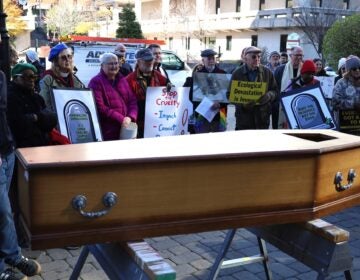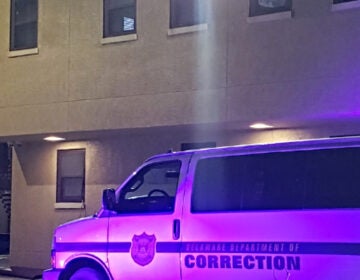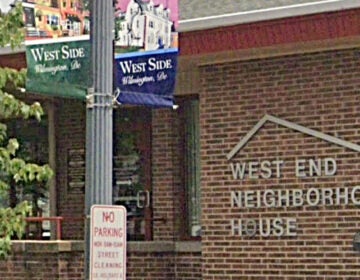Survivor blames officials for Delaware prison riot
Patricia May had a feeling of dread when she reported to work at Delaware's maximum-security prison last year. For months, she had been concerned about her safety.

Former Department of Correction counselor Patricia May describes some of the many paintings by Delaware prison inmates that decorate her home in Hockessin, Del., Monday, July 16, 2018. May, a state corrections counselor who was taken hostage during a deadly riot at Delaware's maximum-security prison, says prison officials are to blame. (AP Photo/Randall Chase)
Patricia May had a feeling of dread when she reported to work at Delaware’s maximum-security prison last year.
For months, May had been concerned about her safety after being assigned to C Building at James T. Vaughn Correctional Center in Smyrna in late 2016.
As she walked to her office on Feb. 1, 2017, the veteran Department of Correction counselor voiced her concerns to a colleague.
“I was expressing my apprehension, my anguish, my anger, my concern,” May told The Associated Press on Friday, in her first public interview since last year’s deadly prison riot . “I thought I was going to get killed in there.”
“It was common knowledge that the riot was going to come about,” she added. “We just didn’t know when.”
Just a few minutes after May expressed her fears, inmates staged a violent uprising in which correctional officer Sgt. Steven Floyd was killed, two others were beaten and tormented, and May was held hostage for almost 20 hours before tactical teams were finally able to breach a wall with a backhoe and rescue her. Three other staffers were rescued after hiding in a basement before climbing onto a roof.
May, who retired in March, blames prison leadership.
“They knew it was going to happen. They did nothing,” she said. “When they put me in that building, they knew they were putting me in a dangerous situation.”
May was included in a $7.55 million settlement of a lawsuit filed on behalf of Floyd’s relatives and six Department of Correction staffers. In settling the lawsuit, state officials did not acknowledge any wrongdoing.
But an independent review ordered by Delaware Gov. John Carney after the riot found that prison administrators dismissed warnings of trouble brewing, including Floyd’s plea to move some inmates to another building for security reasons. The dismissal of the warnings was indicative of an overcrowded, understaffed facility plagued by mismanagement, poor communication, a culture of negativity, and adversarial relationships among prison staff, administrators and inmates, investigators found.
On Tuesday, Carney and corrections officials plan to release a final report on efforts to implement 41 recommendations from the independent review team, which never spoke to May.
“I’m just ticked off that nobody talked to me,” said May, who did arrange a meeting with Carney’s chief legal counsel in June 2017 before Carney announced the hiring of attorney Claire DeMatteis as a special assistant to oversee reform efforts and the review team’s recommendations.
“I greatly respect Ms. May’s service and the trauma she experienced,” DeMatteis said in an email Tuesday.
Recounting an ordeal that has been indelibly etched in her memory, May, 68, said the riot broke out shortly after she received clearance from Floyd to have an inmate visit her in her office. Roughly half an hour into the meeting, another prisoner burst through the door, holding a sharp weapon.
“He called me by name. He said, ‘Ms. May, I don’t want to hurt you, but if you don’t do everything I tell you, I’m going to have to stab you.'”
May was tied up and a hood was placed over her head.
“I’m not Ms. May anymore. I’m a hostage, period,” she said, adding that she could hear sounds of violence outside her door but couldn’t see what was going on. Inmates were ransacking the building, setting fires and barricading doors with water-filled foot lockers.
“The noise level was beyond comprehension. … It was such a rage, I can’t even put it in words,” she said.
As she was led from her office to a cell, May was able to look down through the bottom of the hood. Claustrophobic, she had warned an inmate that if he tied the hood around her neck, she was going to “freak out.”
“When I walked out of the office, the floor was covered with blood. … I didn’t know whose blood it was.”
An inmate later came into the cell and held a phone or radio up to her head, ordering her to tell the person on the other end “how serious this is.”
“There’s blood everywhere,” May said numbly, unable to think of a better way to explain the situation.
In an effort to calm May, a devout Christian, inmates brought her a Bible. With her hood on, she couldn’t read it. She simply clutched it to her chest. Too nervous to eat, she declined food.
An inmate also brought her a radio so she could listen to her favorite Christian rock stations. There was no reception. Undeterred, the inmate, who told May he had recently become a Christian, sang to her.
Eventually, May was allowed to remove her hood. She found herself in the company of three inmates, who joined her in the cell and vowed to protect her. They shared their life stories with her, and she told them how she relied on her Christian faith as a source of hope and strength in times of trouble. May also recounted Bible stories to the inmates, including Daniel’s tribulations in the lion’s den.
About an hour later, shouts began ringing through the hallways.
“They’re coming at us with a backhoe!” inmates hollered.
May and the inmates agreed to close their cell door, knowing they would be trapped if another fire broke, but also afraid responders might come in shooting.
The inmates with May shouted to tactical responders to let them know she was with them and told them where to find the electrical panel to unlock the door.
May recalled only being worried that “my guys would get hurt.”
“They had been so kind to me. … They cared about a counselor they hardly even knew,” she said.
May, who holds a degree in criminology and worked the streets as a probation and parole officer for almost a decade before becoming a counselor, says inmates in the Delaware prison are sorely in need of better conditions, counseling and programs to help them rehabilitate. She said the state is jailing prisoners for “way too long” and that corrections officials “are antiquated in our thinking about treatment.”
“They have to take these reforms seriously,” she said. “If you take all their (inmates’) hope away, what do they have left?”
WHYY is your source for fact-based, in-depth journalism and information. As a nonprofit organization, we rely on financial support from readers like you. Please give today.




